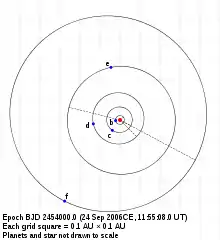 Orbits of the inner planets of the HD 10180 planetary system, using the orbital configuration from an eight-body (the star and seven planets) Newtonian model taking into account tidal dissipation. | |
| Discovery | |
|---|---|
| Discovery date | 24 August 2010 |
| Orbital characteristics | |
| 0.0641 ± 0.0010 AU (9,590,000 ± 150,000 km) | |
| Eccentricity | 0.073±0.031[1] |
| 5.75969±0.00028 d[1] | |
Average orbital speed | 136 |
| 328±24 | |
| Star | HD 10180 |
| Physical characteristics | |
| Mass | >0.0416±0.0014 MJ |
HD 10180 c is an exoplanet approximately 130 light-years away in the constellation Hydrus.[2] It was discovered in 2010 using the radial velocity method.[2] With a minimum mass comparable to that of Neptune,[3] it is of the class of planets known as Hot Neptunes. Dynamical simulations suggest that if the mass gradient was any more than a factor of two, the system would not be stable.
While planet c does not exist in any mean motion resonances, both planets with adjacent orbits (b and d) share near resonances with c.
References
- 1 2 Kane, Stephen R.; Gelino, Dawn M. (2014), "On the Inclination and Habitability of the HD 10180 System", The Astrophysical Journal, 792 (2): 111, arXiv:1408.4150, Bibcode:2014ApJ...792..111K, doi:10.1088/0004-637X/792/2/111, S2CID 42857278
- 1 2 "Open Exoplanet Catalogue - HD 10180 c". www.openexoplanetcatalogue.com. Retrieved 2020-01-09.
- ↑ "Exoplanet-catalog". Exoplanet Exploration: Planets Beyond our Solar System. Retrieved 2020-01-09.
This article is issued from Wikipedia. The text is licensed under Creative Commons - Attribution - Sharealike. Additional terms may apply for the media files.